Top 10 Retail Customer Service Practices to Master in 2025
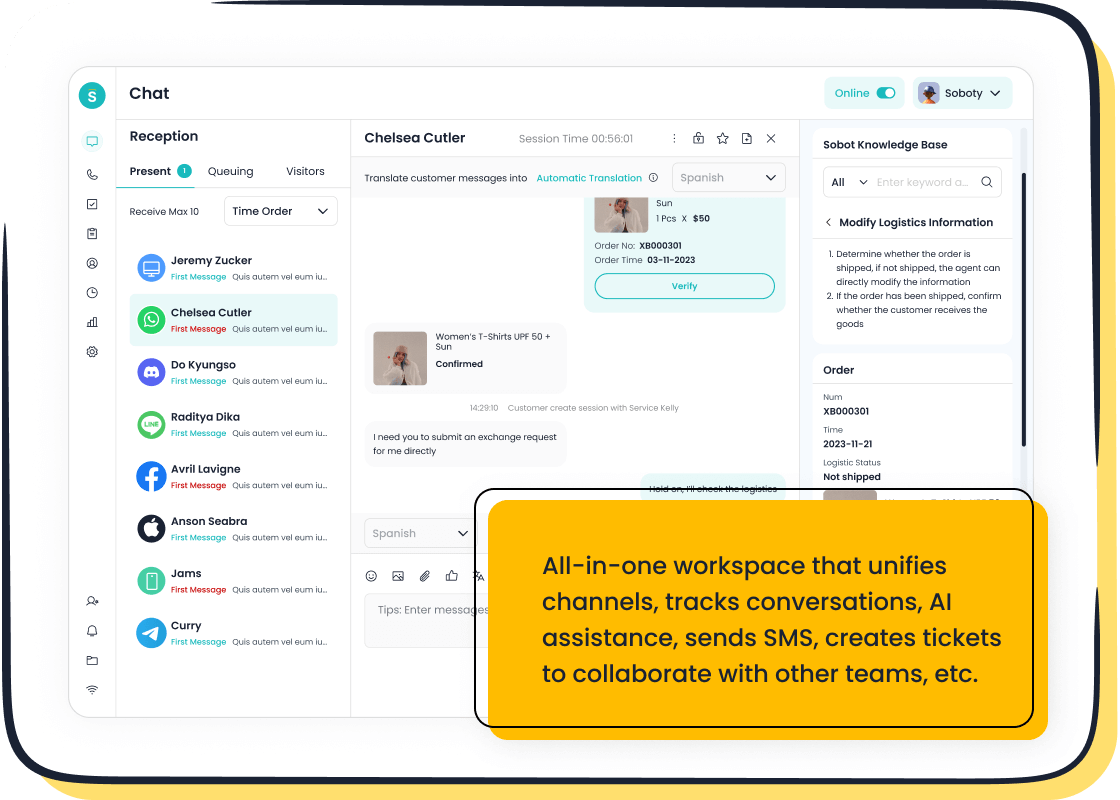
In 2025, customer service in retail isn’t just a support function—it’s the heartbeat of your business. Why? Because your customers expect more than ever before. Did you know 93% of customer service teams agree that expectations are at an all-time high? And here’s the kicker: 70% of customers will drop a brand after a single poor experience. That’s a lot of pressure, right?
But here’s the good news—you can turn this challenge into an opportunity. When you exceed expectations, you’re not just making customers happy. You’re building loyalty. In fact, 96% of customers say a positive experience makes them stick around. Tools like Sobot’s AI-powered solutions help you stay ahead by personalizing every interaction. It’s not just about keeping up. It’s about creating unforgettable customer experiences that set you apart.
Delivering Personalized Customer Experiences at Scale
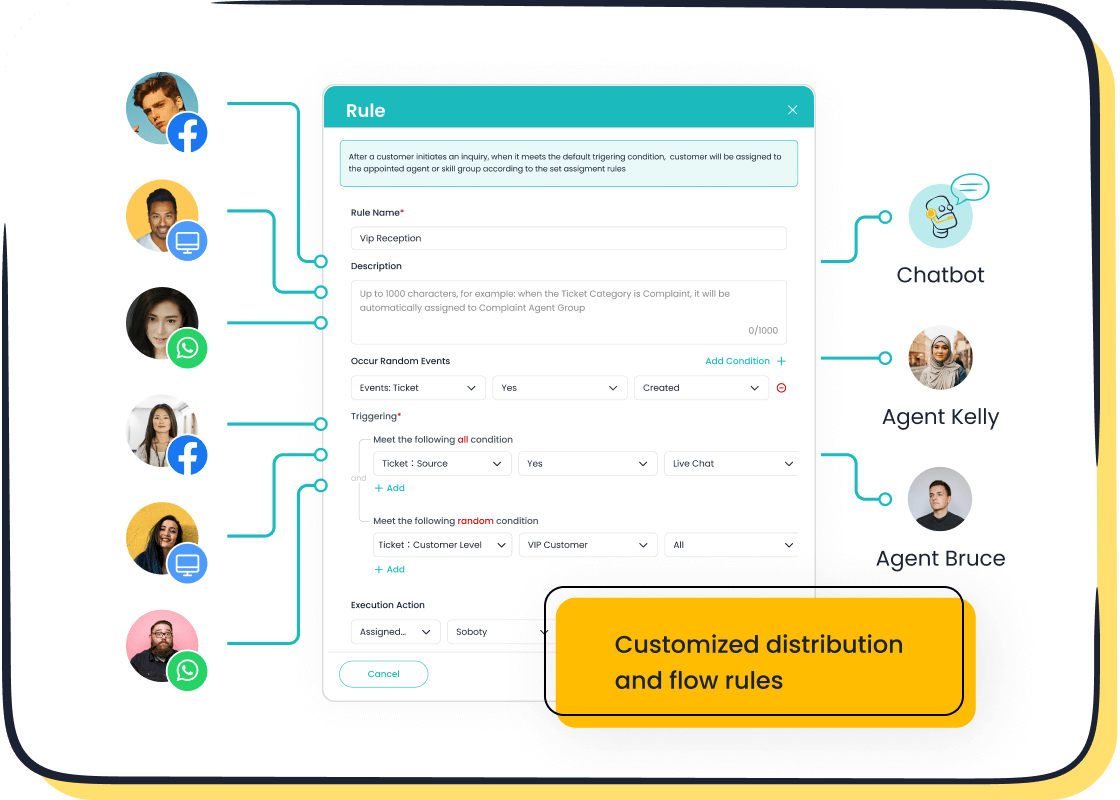
The importance of personalization in retail customer service
Personalization isn’t just a buzzword anymore—it’s the backbone of modern retail customer service. When you tailor experiences to your customers, you’re not just meeting their needs; you’re exceeding their expectations. Think about this: customers are 80% more likely to make a purchase when they feel the experience is personalized. That’s a game-changer for your business.
Personalized customer experiences also build loyalty. Imagine a shopper who receives tailored product recommendations based on their past purchases. They’re not just buying a product; they’re building trust in your brand. This trust translates into repeat business and higher revenue. In fact, retailers who focus on personalization see a 25% increase in revenue.
Leveraging customer data for hyper-personalized approaches
Data is your secret weapon for creating hyper-personalized approaches. By analyzing customer behavior, preferences, and purchase history, you can predict what they want before they even ask. For example, a sporting goods retailer used real-time data to personalize its offerings, leading to a 28% boost in conversion rates.
But it’s not just about sales. Data-driven personalization also enhances the overall customer experience. Customers are 110% more likely to add items to their basket when they feel understood. Plus, they’re willing to pay up to 16% more for a personalized experience.

Tools like Sobot Live Chat for tailored customer interactions
To deliver personalized customer experiences at scale, you need the right tools. Sobot Live Chat is a perfect example. It integrates customer data from multiple channels, allowing you to provide tailored interactions in real time. Whether your customers are on WhatsApp, Instagram, or your website, Sobot ensures they get the same personalized service.
Here’s the kicker: Sobot Live Chat doesn’t just improve customer satisfaction—it boosts your bottom line. Businesses using Sobot have reported a 38% increase in conversion rates. Plus, with features like AI-assisted tools and built-in analytics, you can continuously refine your approach to meet evolving customer needs.
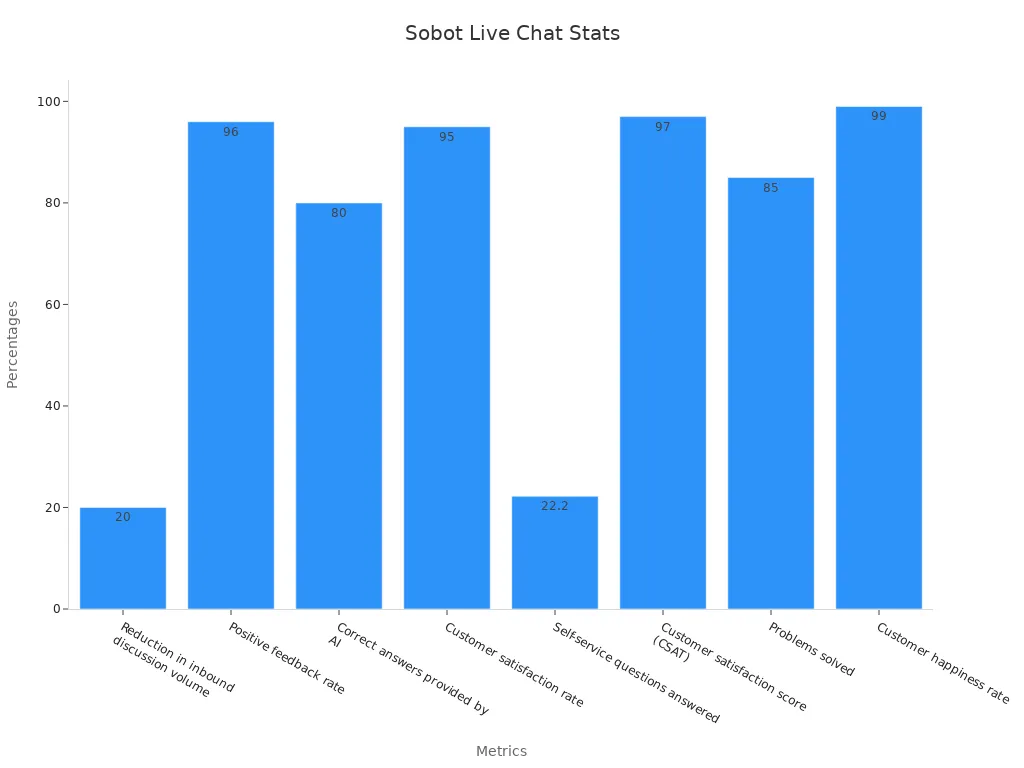
By leveraging tools like Sobot Live Chat, you’re not just keeping up with customer expectations—you’re setting new standards for what great service looks like.
Omnichannel Support for Seamless Customer Experience
Defining omnichannel customer service in retail
Omnichannel support is more than just a buzzword—it’s the gold standard for retail customer service in 2025. It means creating a seamless experience for your customers, no matter where they interact with your brand. Whether they’re browsing your website, chatting on WhatsApp, or visiting your physical store, they expect the same level of service and consistency.
Why does this matter? Because customers value convenience and consistency. Studies show that 84% of consumers believe retailers should integrate online and offline channels. When you deliver this kind of unified experience, you’re not just meeting expectations—you’re exceeding them.
Omnichannel strategies also enhance customer satisfaction by providing real-time information and personalized communication. For example, integrating augmented reality (AR) into your app can let customers "try on" products virtually, while synchronized inventory ensures they know exactly what’s available. These small touches create a big impact on the overall customer experience.
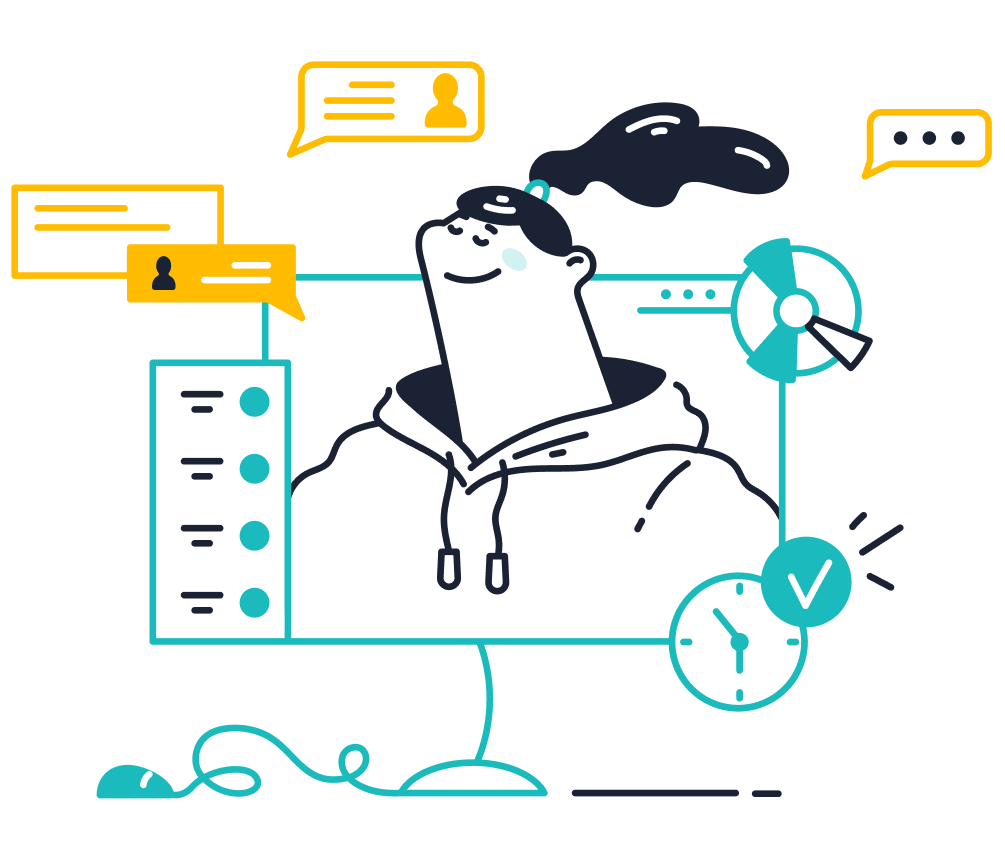
Integrating online and offline channels with Sobot solutions
Bridging the gap between online and offline channels can feel overwhelming, but tools like Sobot make it simple. Sobot’s omnichannel solutions unify all customer interactions into a single platform. This means your team can manage inquiries from social media, email, live chat, and even in-store kiosks without switching systems.
Take smart inventory tracking, for example. With Sobot, you can provide real-time visibility of stock across locations, ensuring customers always get accurate information. Integrated payments streamline the checkout process, whether online or in-store, while sales analytics help you track performance and customer behavior.
| Best Practice | Description |
|---|---|
| Omnichannel Experience | Integrates offline and online channels into a single customer journey. |
| Smart Inventory Tracking | Provides real-time visibility of stock movement across various locations. |
| Integrated Payments | Ensures a fast, secure, and multi-currency checkout experience. |
| Sales & Customer Analytics | Allows tracking of sales performance, behavioral trends, and the success of marketing campaigns. |
| Buy Online and Check Out | Facilitates in-store selection with options to add items to a cart and offers an optimized payment flow. |
Sobot’s solutions don’t just simplify operations—they elevate your customer experience. Samsung, for instance, used Sobot to unify its communication channels and saw a 30% boost in agent efficiency. That’s the power of seamless integration.
Best practices for consistent communication across platforms
Consistency is key when it comes to omnichannel support. Customers want their concerns addressed on the same channel they started with, and 64% are willing to spend more if you meet this expectation.
To achieve this, focus on these best practices:
- Centralize communication: Use tools like Sobot Live Chat to manage all interactions in one place.
- Train your team: Ensure agents are equipped to handle inquiries across multiple platforms.
- Leverage analytics: Use data to identify gaps and improve response times.
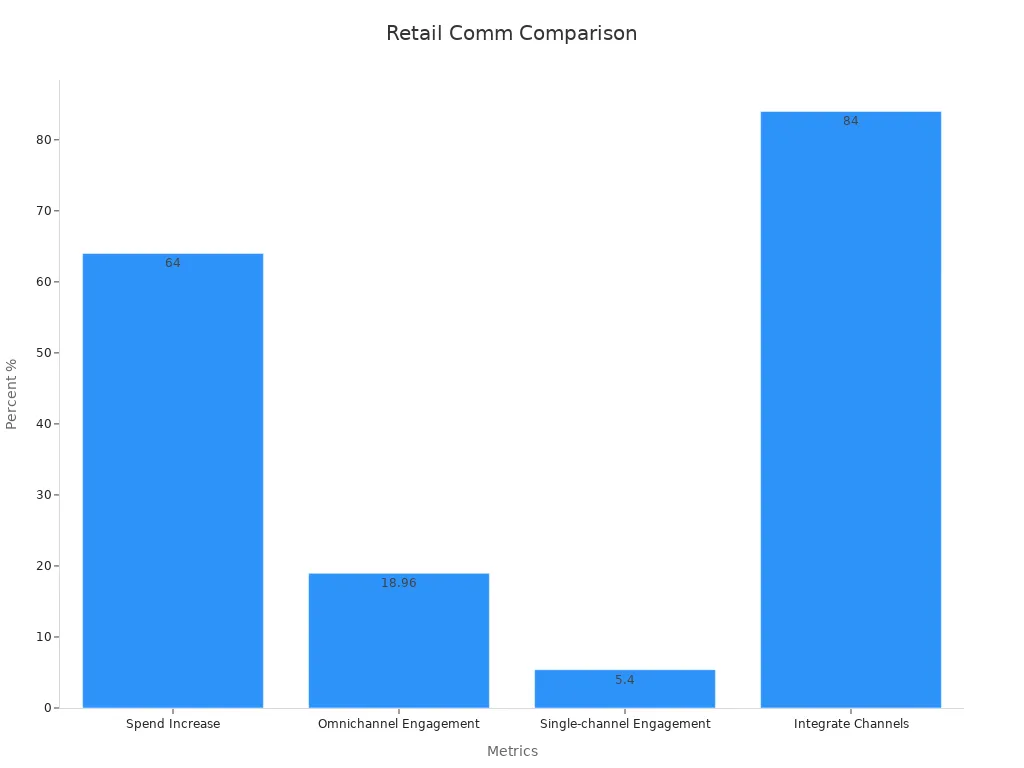
Omnichannel campaigns also outperform single-channel ones, with engagement rates of 18.96% compared to 5.4%. By maintaining consistent communication, you’re not just meeting customer needs—you’re building loyalty that lasts.
AI-Powered Customer Service for Efficiency
How AI transforms customer service in retail
AI is revolutionizing customer service in retail by making it faster, smarter, and more efficient. Imagine a world where your customers get instant answers to their questions, personalized recommendations, and even dynamic discounts—all without waiting. That’s the power of AI. It doesn’t just improve response times; it transforms the entire customer experience.
Take a look at what AI can do:
| Benefit Type | Description |
|---|---|
| Enhanced Personalization | AI enables hyper-personalized shopping experiences, fostering customer loyalty. |
| Real-Time Engagement | Chatbots provide instant support, answering queries and making suggestions. |
| Improved Operational Efficiency | AI automates tasks, allowing employees to focus on high-value activities. |
| Fraud Detection | Monitors transactions in real-time to prevent fraud. |
| Predictive Analytics | Anticipates market trends and adjusts strategies. |
With AI, you’re not just keeping up—you’re staying ahead. For example, companies using AI-powered chatbots have seen a 24% increase in customer satisfaction scores and a 37% improvement in first-contact resolution rates. These numbers show how AI is reshaping the future of retail.
Sobot AI solutions for real-time support and insights
Sobot’s AI solutions take efficiency to the next level. They’re designed to handle routine tasks, like answering FAQs or processing returns, so your team can focus on what really matters—building relationships. Sobot AI doesn’t just stop at automation; it provides real-time insights that help you make smarter decisions.
For instance, Sobot’s AI analyzes customer data to predict buying patterns and recommend products. It also tracks performance metrics, like response times and customer satisfaction, so you can continuously improve. Businesses using Sobot AI have reported a 30% reduction in operational costs and a 68% decrease in cost-per-interaction. That’s not just efficiency—it’s a game-changer.
Balancing AI automation with human empathy
While AI excels at speed and accuracy, it’s the human touch that builds trust. The key is finding the right balance. Let AI handle repetitive tasks, like order tracking, while your team focuses on complex issues that require empathy. This approach not only improves efficiency but also enhances customer satisfaction.
Here’s how you can strike that balance:
| Strategy | Impact on Customer Satisfaction |
|---|---|
| AI handles routine tasks | Frees up human agents for complex interactions |
| Seamless escalation to human agents | Ensures smooth resolution without repetition |
| AI supports human agents | Enables empathy-driven interactions, enhancing trust and loyalty |
By combining AI’s efficiency with human empathy, you create a customer service standard that’s both responsive and personal. As one expert puts it, “AI’s ability to manage routine queries allows human agents to focus on emotionally charged interactions, creating a more attentive and responsive experience.”
Proactive Customer Engagement Strategies
Anticipating customer needs with data-driven insights
Imagine knowing what your customers want before they even ask. That’s the magic of data-driven insights. By analyzing patterns in customer behavior, you can predict their needs and deliver solutions proactively. For example, if a customer frequently buys skincare products, you could recommend a new moisturizer before they run out. This kind of proactivity not only delights customers but also builds trust.
The numbers back this up. According to Accenture, 91% of customers are more likely to shop with brands that recognize and remember them. And here’s another stat: 85% of marketing executives say analytics will drive most of their decisions. When you use data to anticipate needs, you’re not just improving customer service in retail—you’re creating memorable customer experiences that keep people coming back.
| Statistic | Source |
|---|---|
| 91% of customers prefer brands that recognize and remember them. | Accenture |
| 85% of marketing executives rely on analytics for decision-making. | Gartner |
Benefits of proactive communication in retail
Proactive communication is a game-changer. It’s about reaching out to customers before they encounter problems or even realize they have a need. This approach enhances satisfaction by making interactions timely and relevant. For instance, sending a reminder about an expiring warranty or offering a discount on a product they’ve browsed shows you care.
Here’s why it works:
- It boosts loyalty by addressing issues before they escalate.
- It saves time and resources since retaining customers is more cost-effective than acquiring new ones.
- It improves productivity by reducing repetitive inquiries.
In fact, 86% of buyers are willing to pay more for a better customer experience. When you’re proactive, you’re not just solving problems—you’re creating value.

Using Sobot Live Chat to engage customers in real-time
Sobot Live Chat takes proactive customer service to the next level. It allows you to engage with customers in real time, whether they’re browsing your website or chatting on social media. For example, Maruti Suzuki used Sobot’s chatbot to handle millions of queries and facilitate thousands of bookings. The result? Enhanced efficiency and happier customers.
| Case Study | Engagement Metrics | Outcome |
|---|---|---|
| Maruti Suzuki Chatbot | Engaged over 400,000 users, handled millions of queries, facilitated thousands of bookings | Enhanced efficiency and customer satisfaction |
With features like AI-assisted tools and customer segmentation, Sobot Live Chat ensures every interaction feels personal. It’s not just about answering questions—it’s about anticipating them. By using Sobot, you can turn casual visitors into loyal customers while boosting your team’s productivity.
Real-Time Support with Advanced Tools
The growing demand for instant responses in 2025
In 2025, instant responses aren’t just a luxury—they’re a necessity. Customers expect answers now, not later. This shift is driven by the rise of AI and the growing demand for real-time insights. Research shows that 66% of advanced teams have seen a surge in requests for faster insights. Why? Because speed matters. When you respond quickly, you’re not just solving problems—you’re creating a better customer experience.
Here’s the thing: 71% of research teams are now considered strategic partners in their organizations. That’s because timely insights drive better decisions. And with 83% of researchers planning to invest more in AI, it’s clear that instant responses are shaping the future of customer service in retail.
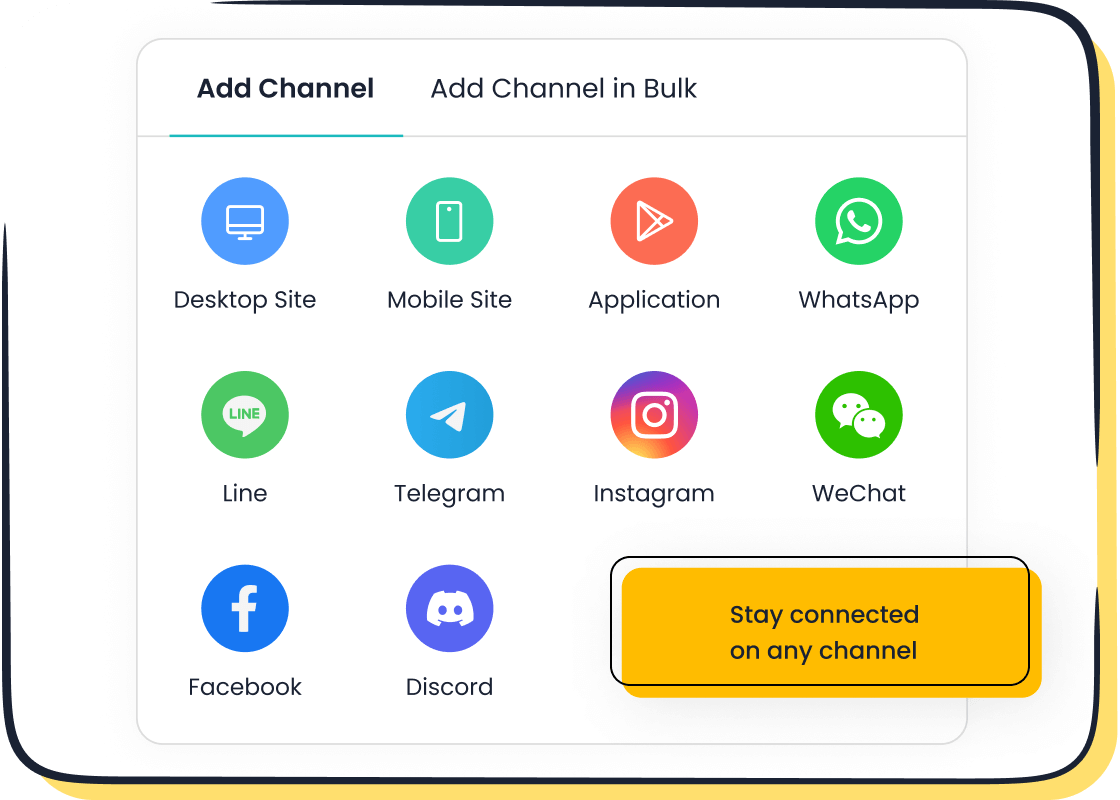
Sobot Live Chat for omnichannel real-time assistance
Meeting the demand for instant responses requires the right tools. That’s where Sobot Live Chat comes in. This platform connects all your communication channels—like WhatsApp, Instagram, and your website—into one seamless system. Whether a customer is browsing your site or messaging you on social media, Sobot ensures they get real-time support.
What makes it stand out? Sobot Live Chat uses AI to assist agents, speeding up response times and improving accuracy. It also offers built-in analytics, so you can track performance and refine your approach. Businesses using Sobot have reported a 38% boost in conversion rates. That’s not just efficiency—it’s a game-changer for your customer service strategy.
Examples of integrating chatbots and live agents
Combining chatbots with live agents is the secret to real-time support. Chatbots handle simple queries, like order tracking, while live agents step in for complex issues. This balance ensures uninterrupted service and keeps customers happy.
Here’s how it works:
- Faster Response Times: Chatbots manage multiple queries at once, reducing wait times.
- Seamless Escalation: When a chatbot can’t resolve an issue, a live agent takes over without missing a beat.
- Personalized Connections: Live agents add a human touch, building trust and loyalty.
For example, a retailer using Sobot’s chatbot saw a significant drop in repetitive inquiries. This freed up their agents to focus on high-value interactions, improving both efficiency and customer satisfaction.
By integrating advanced tools like Sobot Live Chat, you’re not just keeping up with customer expectations—you’re exceeding them.
Empowering Customers with Self-Service Options
The rise of self-service in retail customer service
Self-service options are no longer just a convenience—they’re a necessity in modern customer service in retail. Customers today want quick solutions without waiting for a representative. In fact, studies show that 67% of customers prefer self-service over speaking to an agent. Why? Because it’s faster, easier, and puts them in control of their experience.
Retailers are catching on. From interactive FAQs to AI-powered chatbots, self-service tools are transforming how businesses interact with their customers. These tools empower shoppers to find answers, track orders, or even process returns—all on their own. This shift not only improves the customer experience but also reduces the workload on your support team.
Benefits of AI-powered self-service tools
AI-powered self-service tools take things to the next level. They don’t just answer questions—they anticipate them. Imagine a chatbot that knows a customer’s order history and offers personalized recommendations. That’s the power of AI.
Here’s how these tools benefit your business:
- Faster resolutions: Customers get answers instantly, improving satisfaction.
- Cost savings: Automating repetitive tasks reduces operational costs.
- Increased efficiency: Your team can focus on complex issues instead of routine inquiries.
Take a look at the metrics that highlight the impact of self-service tools:
| Metric Type | Description |
|---|---|
| Employee Satisfaction Metrics | Surveys and feedback focused on scheduling experience and work-life balance. |
| System Utilization Statistics | Adoption rates, frequency of self-service actions, and feature usage patterns. |
| Operational Efficiency Indicators | Time saved on scheduling tasks, reduction in administrative workload, and faster resolution of coverage issues. |
| Business Impact Measures | Changes in turnover rates, absenteeism, punctuality, and overall productivity. |
| ROI Calculations | Assessment of costs versus benefits, including direct and indirect savings. |
These benefits make AI-powered self-service tools a win-win for both customers and businesses.
Examples of Sobot's chatbot and ticketing system
Sobot’s chatbot and ticketing system are perfect examples of how self-service tools can transform customer experiences. The chatbot, powered by AI, handles inquiries 24/7. It can answer FAQs, track orders, and even assist with product recommendations—all in real time. This ensures customers get the help they need, whenever they need it.
The ticketing system complements the chatbot by managing more complex issues. It automates workflows, prioritizes tasks, and ensures no inquiry falls through the cracks. Together, these tools create a seamless self-service experience that boosts customer satisfaction and operational efficiency.
For instance, Samsung used Sobot’s solutions to streamline its customer service operations. The result? A 30% increase in agent efficiency and a 97% customer satisfaction rate. That’s the kind of impact self-service tools can have on your business.
Sustainability as a Customer Service Priority
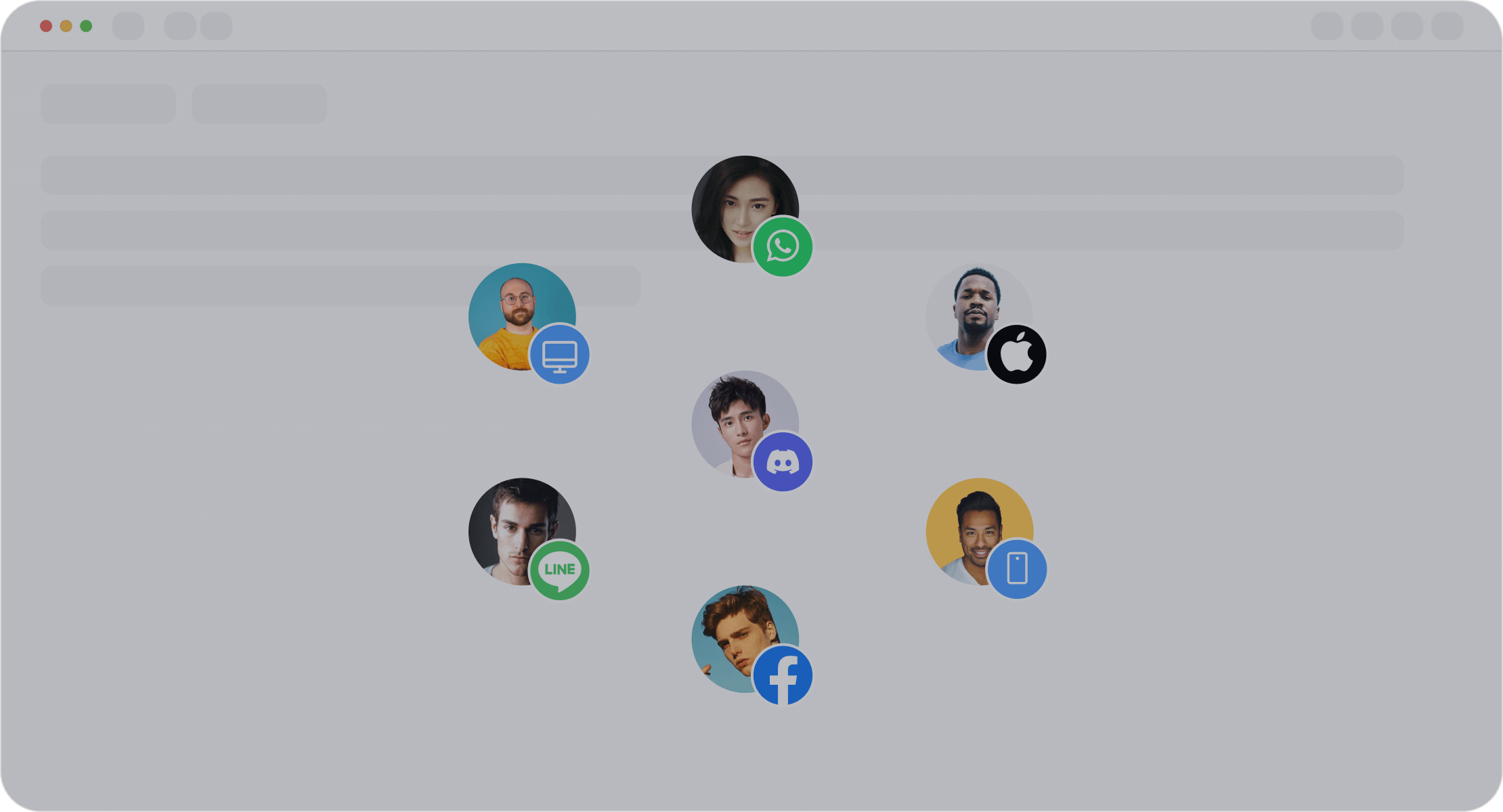
Aligning customer service with eco-friendly practices
Sustainability isn’t just a trend—it’s a priority for modern retail. Customers today care about the planet, and they expect the brands they support to care too. By aligning your customer service with eco-friendly practices, you’re not just helping the environment—you’re building stronger relationships with your customers.
Recent research shows that eco-friendly customer service practices lead to increased satisfaction and loyalty. Customers are more likely to recommend your brand when they see your commitment to sustainability. They’re even willing to pay more for sustainable products. For example, a study of 458 Chilean customers confirmed that green practices positively impact loyalty and customer behavior.
Simple changes can make a big difference. Use digital receipts instead of paper. Offer eco-friendly packaging for returns. Train your team to promote sustainable options. These steps show your customers that you’re serious about making a difference.
Communicating sustainability efforts to customers
It’s not enough to adopt sustainable practices—you need to tell your customers about them. Clear, relatable messaging is key. Studies show that sustainability claims can expand your brand’s reach by 24 to 33 percentage points. But here’s the catch: customers prefer simple messages that connect to their lives.
| Key Findings | Implications for Retail Sustainability Messaging |
|---|---|
| Relatable messages resonate most | Highlight how sustainability benefits customers personally. |
| Local sourcing boosts appeal | Emphasize local connections in your messaging. |
| Avoid overly technical claims | Focus on outcomes that matter to customers. |
For example, instead of saying, “Our products are made with 30% recycled materials,” you could say, “By choosing this product, you’re helping reduce waste in your community.” This approach makes your efforts feel personal and impactful.
How Sobot supports sustainable customer service operations
Sobot helps you integrate sustainability into your customer service seamlessly. With tools like Sobot Live Chat, you can reduce paper waste by digitizing customer interactions. The platform’s AI-powered features also optimize workflows, cutting down on energy consumption and unnecessary resources.
Sobot’s solutions go beyond efficiency. They help you communicate your sustainability efforts effectively. For instance, you can use built-in analytics to track and share your progress with customers. Samsung, a Sobot client, achieved a 97% customer satisfaction rate while streamlining operations sustainably.
By choosing Sobot, you’re not just improving your customer experience—you’re contributing to a greener future.
Training and Empowering Customer Service Teams
The importance of continuous training for retail agents
Your customer service team is the face of your brand. Their ability to handle inquiries, resolve issues, and create memorable experiences directly impacts your success. That’s why continuous training isn’t optional—it’s essential. In fact, companies that invest in employee training see a 24% higher profit margin compared to those that don’t.
Training keeps your team sharp and ready to adapt to changing customer expectations. For example, as AI tools like Sobot Live Chat become more integrated into customer service in retail, agents need to know how to use them effectively. Regular workshops, role-playing scenarios, and even gamified learning modules can make training engaging and impactful.
When your team feels confident and capable, they’re more likely to deliver exceptional service. This not only boosts customer satisfaction but also drives support-driven growth for your business.
Tools and strategies for empowering support teams
Empowering your team goes beyond training. It’s about giving them the tools and autonomy to excel. Start by equipping them with technology that simplifies their work. Platforms like Sobot unify customer interactions across channels, so agents can focus on solving problems instead of juggling systems.
Encourage collaboration by fostering a supportive environment. Weekly team huddles or feedback sessions can help agents share insights and learn from each other. Also, recognize their efforts. A simple “great job” or a small reward can go a long way in boosting morale.
Finally, empower your team to make decisions. When agents can resolve issues without waiting for approvals, they feel trusted and valued. This approach not only improves efficiency but also contributes to support-driven growth by creating a more responsive customer service experience.
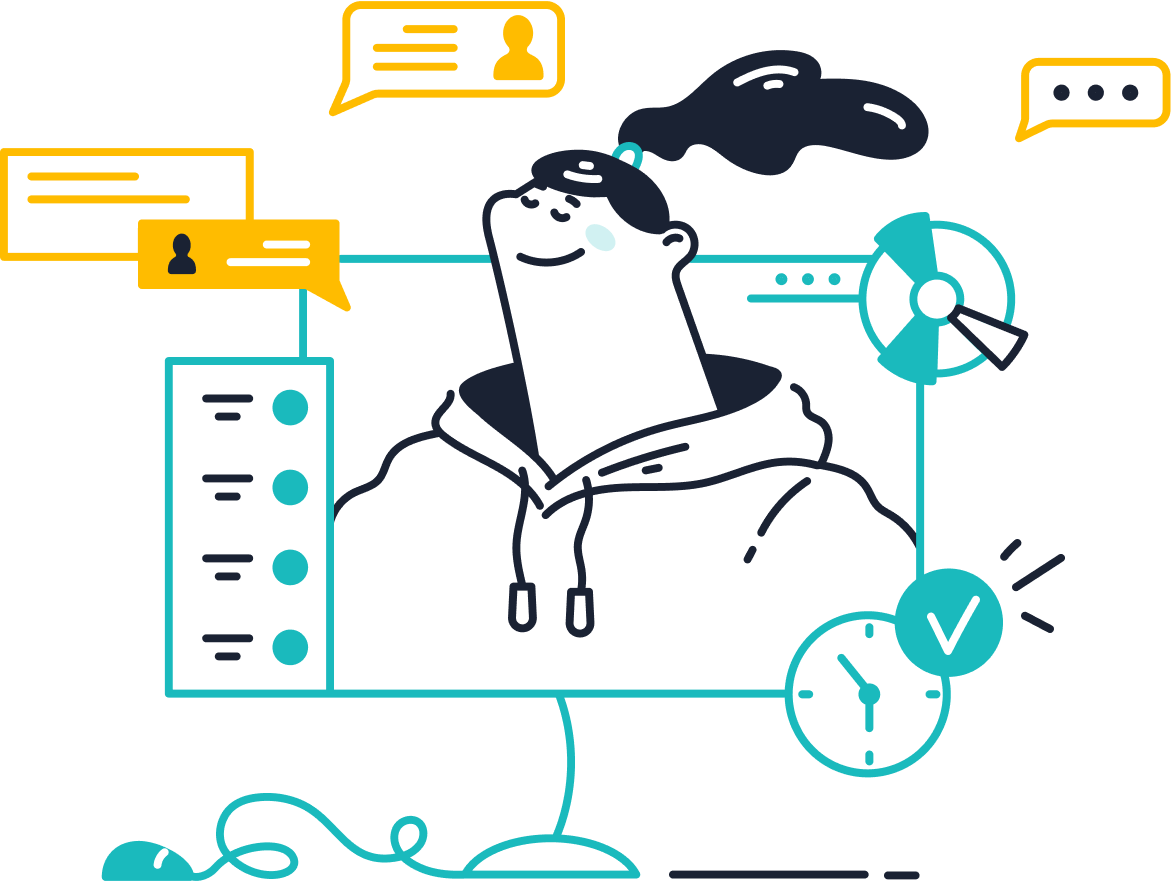
Sobot's role in enhancing agent efficiency and satisfaction
Sobot plays a pivotal role in transforming how your team works. Its AI-powered tools, like the Live Chat platform, streamline workflows and reduce repetitive tasks. For instance, Sobot’s chatbot can handle FAQs, freeing agents to focus on complex issues that require a human touch.
The platform also provides built-in analytics, offering insights into performance metrics like response times and customer satisfaction. These insights help you identify areas for improvement and celebrate successes. Samsung, a Sobot client, saw a 30% increase in agent efficiency after implementing Sobot’s solutions.
By simplifying processes and enhancing productivity, Sobot not only improves operational efficiency but also boosts agent satisfaction. When your team feels supported, they’re more motivated to deliver outstanding service, driving support-driven growth for your business.
Data-Driven Decision Making in Retail
Using analytics to improve customer service in retail
Data is the backbone of modern retail. By analyzing customer behavior, preferences, and trends, you can make smarter decisions that directly improve customer satisfaction. Imagine knowing which products your customers love or identifying bottlenecks in your service process. That’s the power of analytics.
For example, retailers using data-driven strategies have seen a 33% reduction in customer churn and a 49% increase in customer satisfaction scores. These insights help you anticipate customer needs, optimize inventory, and even personalize marketing campaigns. The result? Better customer experiences and stronger loyalty.
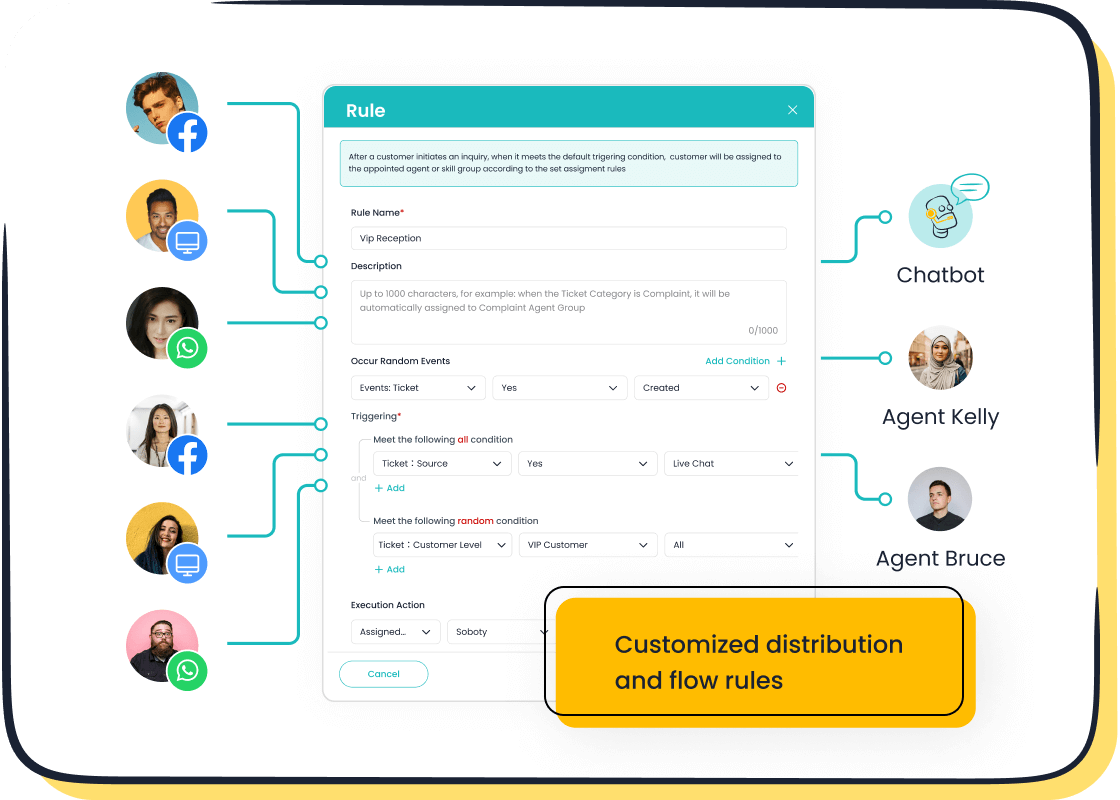
Sobot's built-in analytics for actionable insights
Sobot takes analytics to the next level with its built-in tools. These features provide real-time insights into customer interactions, helping you identify trends and improve your service. For instance, Sobot evaluates over 150 indicators, from response times to customer feedback, giving you a clear picture of what’s working and what needs improvement.
With Sobot, you can track metrics like customer satisfaction scores and resolution times. This data empowers your team to make informed decisions, whether it’s adjusting workflows or refining your approach to customer engagement. Businesses using Sobot have reported a 32% reduction in resolution times and a 28% decrease in operational costs. That’s efficiency you can measure.
Benefits of data-driven strategies for customer satisfaction
Data-driven decision-making offers measurable benefits that transform your business. Here’s a snapshot of what you can achieve:
| Benefit Description | Statistic |
|---|---|
| Customer retention rates | 62% higher |
| Reduction in customer churn | 33% reduction |
| Customer lifetime value | 3.5x greater |
| Campaign engagement rates | 38% higher |
| Improvement in customer acquisition efficiency | 27% improvement |
| Increase in customer satisfaction scores | 49% increase |
| Reduction in inventory costs | 15-20% reduction |
| Improvement in profit margins | 3-5% improvement |
| Decrease in stock-outs | 25% decrease |
| Reduction in customer service resolution times | 32% reduction |
| Higher employee productivity in customer-facing roles | 41% higher |
| Decrease in operational costs related to customer management | 28% decrease |
By leveraging analytics, you’re not just improving operations—you’re creating customer experiences that stand out. Tools like Sobot make it easy to turn data into action, helping you stay ahead in a competitive market.
Building Emotional Connections with Customers
The role of empathy in retail customer interactions
Empathy is the secret ingredient to creating unforgettable customer experiences. When you understand your customers’ emotions, you’re not just solving problems—you’re building trust. Research shows that 95% of purchase decisions happen subconsciously, driven by emotions. This means every interaction is an opportunity to connect on a deeper level.
Empathy also plays a critical role in customer retention. A single negative experience can push 80% of customers to switch brands. By addressing emotional triggers—like frustration or uncertainty—you can turn potential issues into moments of delight. For example, using technologies like augmented reality to ease anxieties about product fit can make customers feel valued and understood.
Strategies for fostering emotional connections
Building emotional connections doesn’t have to be complicated. Start by making every interaction personal. Use customer data to tailor your approach, whether it’s recommending products based on past purchases or sending a thoughtful follow-up message.
Here are some simple strategies to strengthen emotional bonds:
- Listen actively: Pay attention to what your customers say and respond with genuine care.
- Be proactive: Anticipate their needs before they even ask.
- Show appreciation: A small thank-you note or exclusive offer can go a long way.
Tools like Sobot Live Chat make this easier. By integrating customer data across channels, Sobot helps you deliver personalized interactions that resonate emotionally. For instance, its AI-powered features can identify patterns in customer behavior, allowing you to address concerns before they escalate.
Examples of brands excelling in emotional engagement
Some brands have mastered the art of emotional connection, turning casual shoppers into lifelong fans. Take Nike’s "Just Do It" campaign—it inspires customers by tapping into their aspirations, creating a powerful emotional bond. Patagonia goes a step further by aligning with customers’ values through its sustainability efforts, like the "Worn Wear" campaign.
Other examples include:
- Apple: Builds a sense of community and belonging through innovative branding.
- Coca-Cola: Evokes nostalgia and happiness with consistent messaging.
- Urban Threads: Uses personalized emotional branding to boost satisfaction and repeat purchases.
- Adventure Explorers: Maintains emotional consistency, enhancing engagement and bookings.
These brands prove that emotional connections aren’t just good for the heart—they’re great for business. By focusing on empathy and emotional engagement, you can create customer experiences that truly stand out.
Mastering customer service in retail for 2025 means embracing innovation and putting your customers first. From delivering personalized experiences to leveraging AI-powered solutions, these practices aren’t just trends—they’re game-changers. They help you build loyalty, boost satisfaction, and grow your business.
Here’s why Sobot is your perfect partner:
- Omnichannel support improves customer satisfaction by 20%.
- AI integration enhances efficiency and engagement.
- Seamless data integration and smart tools simplify customer management.
| Metric/Trend | Impact on Customer Service |
|---|---|
| Omnichannel support | 20% improvement in customer satisfaction |
| AI integration | Enhances operational efficiency and customer engagement |
By adopting these strategies and using tools like Sobot Live Chat, you’re not just keeping up—you’re leading the way. Ready to transform your customer service? Let Sobot help you make it happen.
FAQ
1. How does Sobot Live Chat improve customer satisfaction?
Sobot Live Chat ensures customers get instant responses on their preferred channels, like WhatsApp or Instagram. Its AI tools personalize interactions, boosting satisfaction by 38%. Plus, built-in analytics help you refine your approach for even better results.
Tip: Use Sobot’s free trial to see how it transforms your customer service.
2. Can Sobot solutions handle high volumes of customer inquiries?
Absolutely! Sobot’s AI-powered tools, like chatbots, manage repetitive queries 24/7. For example, Samsung used Sobot to streamline operations, achieving a 30% efficiency boost while maintaining a 97% satisfaction rate.
3. What industries benefit most from Sobot’s solutions?
Sobot serves diverse industries, including retail, finance, and gaming. Retailers, for instance, use Sobot to unify online and offline channels, ensuring seamless customer experiences.
| Industry | Benefit Example |
|---|---|
| Retail | Omnichannel support for consistency |
| Finance | Secure, compliant customer interactions |
| Gaming | Real-time support for global players |
4. How does Sobot ensure data security?
Sobot prioritizes security with GDPR compliance, data encryption, and continuous backups. These measures protect customer data while maintaining system stability at 99.99%.
5. What makes Sobot’s AI solutions unique?
Sobot’s AI doesn’t just automate tasks—it provides actionable insights. For example, its AI copilots assist agents with response suggestions, improving resolution times by 32%. This blend of automation and intelligence sets Sobot apart.
Note: Learn more about Sobot’s AI capabilities here.
See Also
Best Customer Support Tools to Use in 2024
Effective Strategies for Quality Management in Call Centers
Excelling at Live Chat for Retail Businesses
Best Customer Feedback Tools to Consider in 2024
A Guide to Implementing Omnichannel Contact Center Strategies
